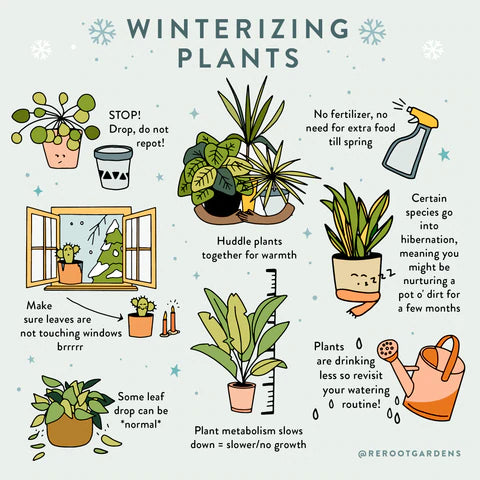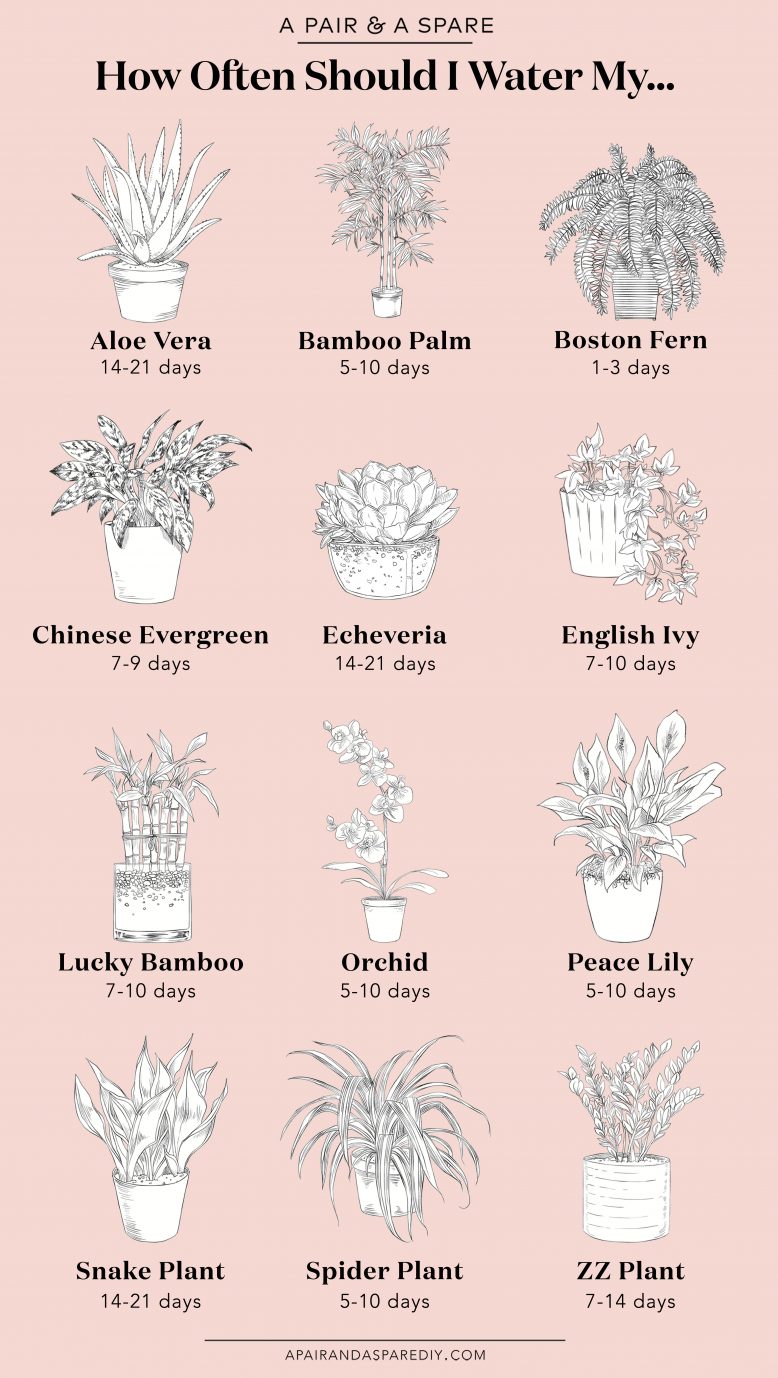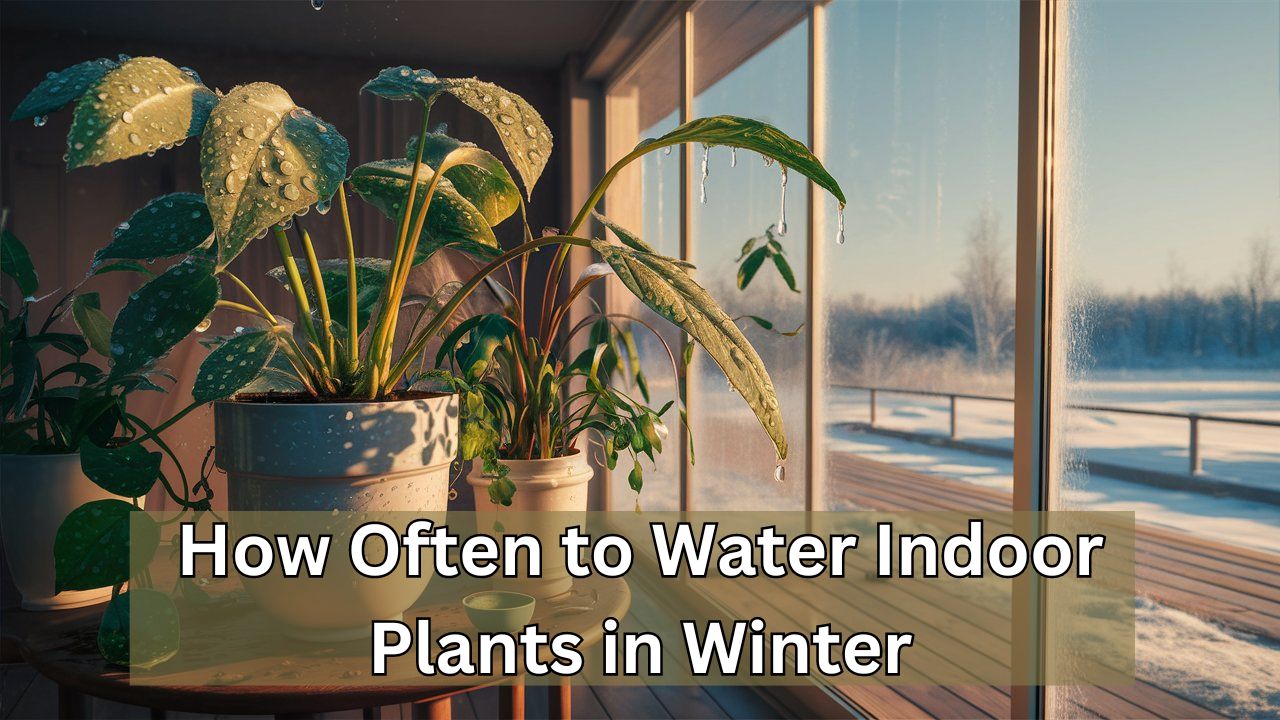Water indoor plants every 10-14 days in winter. Adjust frequency based on plant type and indoor humidity.
Winter can be a challenging time for indoor plants. Reduced sunlight and lower temperatures slow down their growth. Consequently, plants require less water compared to other seasons. Overwatering can lead to root rot and other issues. It’s crucial to monitor the soil moisture regularly.
Use your finger to check if the top inch of soil is dry before watering. Some plants may need more frequent watering, while others can thrive with less. Always consider the specific needs of each plant. Proper watering ensures healthy plants throughout the winter months.
Winter Watering Basics
Indoor plants need special care during winter. The cold season affects their water needs. Understanding the basics helps keep your plants healthy. Let’s dive into the essentials of winter watering.
Factors Affecting Water Needs
Various factors influence how much water your indoor plants need:
- Temperature: Lower temperatures mean plants use less water.
- Humidity: Dry indoor air can make plants lose moisture faster.
- Light: Less sunlight reduces the plant’s water consumption.
- Soil Type: Some soils retain water better than others.
- Plant Type: Different plants have different water needs.
Signs Of Overwatering And Underwatering
Recognizing these signs helps you adjust your watering habits:
| Condition | Signs |
|---|---|
| Overwatering |
|
| Underwatering |
|
Adjust your watering based on these signs to keep your plants thriving in winter.
Plant Types And Water Requirements
Understanding the water requirements of your indoor plants during winter is essential. Different plant types need different care. Let’s explore the specific needs of succulents, cacti, and tropical plants.
Succulents And Cacti Care
Succulents and cacti are resilient. They store water in their leaves and stems. This means they need less frequent watering during winter.
- Water every three to four weeks.
- Ensure the soil is completely dry before watering again.
- Use a pot with drainage holes to avoid waterlogging.
Overwatering can lead to root rot. Always check the soil moisture before adding more water.
Tropical Plants Hydration
Tropical plants need more water than succulents and cacti. They thrive in humid environments.
- Water once a week.
- Ensure the top inch of soil is dry before the next watering.
- Use lukewarm water to keep roots warm.
Maintaining humidity is crucial. Mist the leaves regularly to mimic their natural habitat.
| Plant Type | Watering Frequency | Additional Tips |
|---|---|---|
| Succulents and Cacti | Every 3-4 weeks | Ensure soil is dry before watering |
| Tropical Plants | Once a week | Mist leaves regularly |
By understanding the specific needs of your plants, you can ensure they thrive even in winter.
Assessing Your Indoor Environment
Knowing how often to water indoor plants in winter starts with assessing your indoor environment. Factors like humidity, temperature, and light exposure play crucial roles. These factors determine your plant’s water needs.
Humidity Levels
Winter air tends to be dry. Indoor heating systems reduce humidity further. Low humidity means plants lose water faster through leaves.
Use a humidity meter to check levels. Ideal indoor humidity for most plants is between 40% and 60%. If levels are lower, consider using a humidifier. Grouping plants together also helps increase humidity.
Temperature And Light Exposure
Temperature fluctuations impact your plant’s water needs. Most indoor plants thrive at temperatures between 65°F and 75°F.
Place plants away from radiators and cold drafts. Ensure they receive adequate light. Winter days are shorter, so consider using grow lights.
Check if your plants are getting enough light by observing leaf color and growth. Yellow or dropping leaves indicate insufficient light.
| Factor | Ideal Range | Actions |
|---|---|---|
| Humidity | 40%-60% | Use humidifier, group plants |
| Temperature | 65°F-75°F | Avoid radiators, use grow lights |
| Light | Bright, indirect | Check leaf color, use grow lights |
Following these tips helps ensure your indoor plants stay healthy during winter. Adjust watering based on your unique environment.

Credit: www.rerootgardens.com
Watering Techniques For Cold Months
Winter can be tricky for indoor plant care. Watering techniques must be adjusted for the cold months. Here, we explore effective ways to keep your indoor plants healthy during winter.
Soil Moisture Testing
Proper watering starts with soil moisture testing. Use your finger to check the soil. Insert your finger about an inch deep. If it feels dry, it’s time to water.
For more accuracy, consider a soil moisture meter. These devices offer precise readings. They help prevent overwatering or underwatering. Always remember, less water is needed in winter.
Bottom Watering Method
The bottom watering method is very effective. Place the plant pot in a dish of water. Allow the soil to soak up water from the bottom.
This technique ensures even moisture distribution. It also prevents root rot. Leave the pot in the water for about 20 minutes. Then, remove and allow excess water to drain.
Here’s a quick step-by-step guide:
- Fill a shallow dish with water.
- Place the plant pot in the dish.
- Wait for 20 minutes.
- Remove the pot and let it drain.
Following these techniques keeps your indoor plants happy during winter. Always check soil moisture before watering. Use bottom watering for better results.
Frequency Adjustments
Winter presents unique challenges for indoor plant care, especially in terms of watering. Plants need less water in the colder months. Let’s explore how you can adjust your watering frequency.
Schedule Modifications
During winter, indoor plants often need less water. The lower light levels and cooler temperatures slow their growth. Adjust your watering schedule accordingly. Here’s a simple table to guide you:
| Plant Type | Summer Watering | Winter Watering |
|---|---|---|
| Succulents | Every 2 weeks | Every 3-4 weeks |
| Tropical Plants | Once a week | Every 2 weeks |
| Ferns | Twice a week | Once a week |
Use this table to modify your watering schedule. This ensures your plants receive the right amount of water.
Monitoring Plant Responses
Watch your plants closely. They will show signs if they need more or less water. Droopy leaves might mean they are thirsty. Yellowing leaves could signal overwatering.
- Check the soil moisture before watering.
- Stick your finger an inch into the soil.
- If it’s dry, it’s time to water.
Remember to water less frequently in winter. It’s easier to recover from underwatering than overwatering. Adjust your schedule based on these responses.
:strip_icc()/how-to-water-houseplants-5651236-primary-3aa1e5b5021640ee96184b6755caa964.jpg)
Credit: www.bhg.com
Fertilization And Dormancy
Understanding fertilization and dormancy is crucial for winter plant care. During winter, indoor plants have different needs. This guide will help you know how to care for your plants.
Nutrient Needs In Winter
Indoor plants need fewer nutrients in winter. Their growth slows down. Over-fertilizing can harm them. Use a balanced liquid fertilizer sparingly. Monthly feeding is enough for most plants. Some plants may need less.
To avoid over-fertilizing, monitor your plant’s growth. If leaves are yellowing, check the soil. Too much fertilizer can cause root burn. Always follow the instructions on the fertilizer package.
Understanding Plant Dormancy
Many indoor plants go into a dormant state in winter. This means they rest and grow less. During dormancy, plants need less water and nutrients. Recognize signs of dormancy, such as slower growth and fewer leaves.
Not all plants go dormant. Research your specific plant’s needs. Adjust care routines based on dormancy status. Proper care during dormancy ensures healthy growth in spring.
| Plant Type | Watering Frequency (Winter) | Fertilization Frequency (Winter) |
|---|---|---|
| Cacti and Succulents | Every 3-4 weeks | Not needed |
| Tropical Plants | Every 1-2 weeks | Once a month |
| Flowering Plants | Every 1-2 weeks | Once a month |
Winter care for indoor plants requires attention to both nutrients and dormancy. Adjust your routine for a healthy, thriving indoor garden.
Common Mistakes To Avoid
Winter brings unique challenges for indoor plant care. Many plant lovers make mistakes with watering during this season. Understanding these mistakes can help keep your plants healthy.
Neglecting The Seasonal Change
Winter changes how much water plants need. Neglecting this change is a common mistake. During winter, indoor plants need less water. Most plants grow slower due to less sunlight. Overwatering can lead to root rot.
Check the soil before watering. If the top inch is dry, it’s time to water. Avoid watering on a fixed schedule. Each plant has different needs. Adjust based on the plant type and indoor conditions.
Overcompensating With Water
Another mistake is overcompensating with water. Some think plants need more water in winter due to indoor heating. This is not true. Overwatering can suffocate roots. Roots need oxygen to stay healthy.
Use a pot with drainage holes. This helps excess water escape. Place a saucer under the pot to catch drips. Empty the saucer after watering. This prevents roots from sitting in water.
| Common Mistakes | Solutions |
|---|---|
| Ignoring Seasonal Change | Check soil moisture regularly. Water only when needed. |
| Overwatering Due to Indoor Heating | Use pots with drainage. Empty saucers after watering. |
To keep indoor plants healthy in winter, avoid these mistakes. Adjust your watering habits with the season. Your plants will thank you!

Credit: collectivegen.com
Additional Care Tips
Winter can be a challenging time for indoor plants. Cold temperatures and dry air can stress them. Here are some additional care tips to help your plants thrive.
Grouping Plants For Humidity
Indoor plants often need more humidity in winter. Grouping plants can help maintain higher humidity levels. Place plants close to each other. This creates a micro-environment with higher moisture. You can also use a humidity tray. Fill a shallow tray with pebbles and water. Place your plants on the tray. The water will evaporate, increasing humidity.
Using Mulch For Moisture Retention
Mulch helps keep soil moist. It reduces water evaporation. Use organic mulch like bark or compost. Spread a thin layer on top of the soil. This also helps insulate the roots from cold temperatures.
Advanced Tips For Plant Enthusiasts
Indoor plant care in winter can be tricky. Advanced enthusiasts need special tips. Below are advanced tips for keeping plants healthy in winter.
Installing A Humidifier
Winter air is dry. A humidifier can help. Humidifiers add moisture to the air. This helps plants stay hydrated. Place the humidifier near your plants. Choose a cool-mist humidifier. It is better for plants. Keep it clean. A dirty humidifier can spread mold. Set it to run during the day. Plants need humidity when they photosynthesize.
Creating A Watering Calendar
Watering schedules change in winter. Plants need less water. Create a watering calendar. Track when you water each plant. Use a table or chart. This helps avoid overwatering. Overwatering is common in winter. Check the soil before watering. The top inch should be dry. Water deeply but less often. This encourages strong roots.
| Plant Name | Last Watered | Next Watering |
|---|---|---|
| Fiddle Leaf Fig | Dec 1 | Dec 15 |
| Snake Plant | Dec 10 | Dec 30 |
| Peace Lily | Dec 5 | Dec 20 |
Keep the calendar visible. Update it regularly. This helps maintain a routine.
Frequently Asked Questions
Should I Water Indoor Plants In Winter?
Yes, you should water indoor plants in winter. Reduce the frequency as plants need less water. Ensure soil is dry before watering.
How Often Should I Water Indoor Plants?
Water indoor plants once a week. Adjust frequency based on plant type, season, and soil dryness. Check soil before watering.
How Often Should Plants Be Watered In Winter?
Water plants less frequently in winter. Check soil moisture before watering. Typically, water every 2-3 weeks. Avoid overwatering.
How Often Should You Mist Indoor Plants?
Mist indoor plants 2-3 times per week. Increase frequency during dry seasons or if air is particularly dry.
Conclusion
Watering indoor plants in winter requires careful attention. Adjust your watering schedule based on the plant’s needs. Monitor soil moisture and ensure proper drainage. Less frequent watering can prevent root rot. Always consider plant type and indoor conditions. Following these tips will help your indoor plants thrive during the colder months.

My mission is to help you bring the beauty of nature indoors with expert advice, detailed plant care guides, and creative design ideas.




